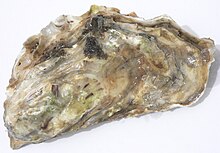
Lee Alexander McQueen was a British fashion designer and couturier. He founded his own Alexander McQueen label in 1992, and was chief designer at Givenchy from 1996 to 2001. His achievements in fashion earned him four British Designer of the Year awards, as well as the Council of Fashion Designers of America International Designer of the Year award in 2003. McQueen died by suicide in 2010 at the age of 40, at his home in Mayfair, London, shortly after the death of his mother.
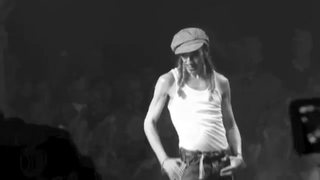
John Charles Galliano,, is a British fashion designer born in Gibraltar. He was the creative director of his eponymous label John Galliano and French fashion houses Givenchy and Dior. Since 2014, Galliano has been the creative director of Paris-based fashion house Maison Margiela. Galliano has been named British Designer of the Year four times. In a 2004 poll for the BBC, he was named the fifth most influential person in British culture.

A crinoline is a stiff or structured petticoat designed to hold out a skirt, popular at various times since the mid-19th century. Originally, crinoline described a stiff fabric made of horsehair ("crin") and cotton or linen which was used to make underskirts and as a dress lining. The term crin or crinoline continues to be applied to a nylon stiffening tape used for interfacing and lining hemlines in the 21st century.

Christian Dior SE, commonly known as Dior, is a French multinational luxury fashion house controlled and chaired by French businessman Bernard Arnault, who also heads LVMH. Dior holds 42.36% shares and 59.01% of voting rights within LVMH.

Shalom Harlow is a Canadian model and actress. She began her career in the early 1990s and by the end of the decade was at supermodel status. In 2007, Forbes listed her as thirteenth in the list of the World's Top-Earning Supermodels. She has also appeared in films such as In & Out (1997) and How to Lose a Guy in 10 Days (2003) and hosted MTV's House of Style alongside fellow model Amber Valletta.
Balenciaga is a Spanish luxury fashion line that was founded in 1919 by couturier Cristóbal Balenciaga in San Sebastián. Balenciaga produces ready-to-wear footwear, handbags, and accessories, and licenses its name and branding to Coty for fragrances. It is currently owned by the French corporation Kering.
Alexander McQueen is a British luxury fashion house founded by the designer Alexander McQueen in 1992. After his death, Sarah Burton was its creative director, from 2010 to 2023. Its current creative director is Seán McGirr.
Maison Margiela, formerly Maison Martin Margiela, is a French luxury fashion house founded by Belgian designer Martin Margiela and Jenny Meirens in 1988 and headquartered in Paris. The house produces both haute couture-inspired artisanal collections and ready-to-wear collections, with the former influencing the designs of the latter. Product lines include womenswear, menswear, jewellery, footwear, accessories, leather goods, perfumes and household goods. Known for deconstructive and avant-garde designs with unconventional materials, Maison Margiela has traditionally held live shows in unusual settings, for example empty metro stations and street corners. Models' faces are often obscured by fabric or long hair to direct attention to the clothes and design. Margiela resigned as creative designer in 2009 and John Galliano was appointed to the role in 2014.

The Widows of Culloden is the twenty-eighth collection by British fashion designer Alexander McQueen, made for the Autumn/Winter 2006 season of his eponymous fashion house. It was inspired by his Scottish ancestry and is regarded as one of his most autobiographical collections. It is named for the widows of the Battle of Culloden (1746), often seen as a major conflict between Scotland and England. Widows makes extensive use of the McQueen family tartan and traditional gamekeeper's tweeds, as well as other elements taken from Highland dress. Historical elements reflected the fashion of the late Victorian era and the 1950s.

A sari-inspired dress incorporates attributes of the Indian sari into its design. This includes how it drapes, its embellishment and colours.

The illusion of Kate Moss is an art piece first shown at the conclusion of the Alexander McQueen runway show The Widows of Culloden. It consists of a short film of English model Kate Moss dancing slowly while wearing a long, billowing gown of white chiffon, projected life-size within a glass pyramid in the centre of the show's catwalk. Although sometimes referred to as a hologram, the illusion was made using a 19th-century theatre technique called Pepper's ghost.
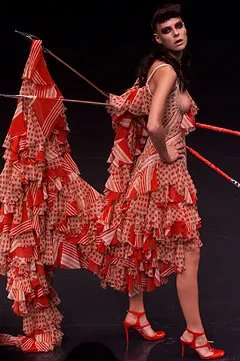
The Dance of the Twisted Bull is the nineteenth collection by British designer Alexander McQueen for his eponymous fashion house. Twisted Bull was inspired by Spanish culture and art, especially the traditional clothing worn for flamenco dancing and bullfighting. In McQueen's typical fashion, the collection included sharp tailoring and historicist elements and emphasised femininity and sexuality.
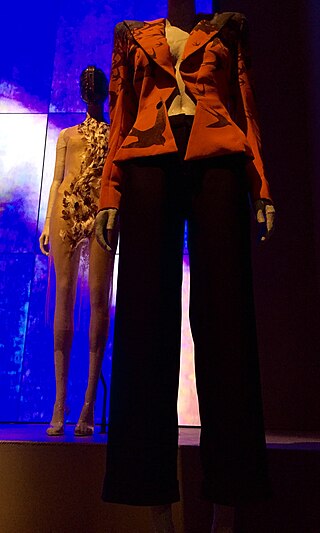
The Birds is the fifth collection by British designer Alexander McQueen for his eponymous fashion house. The Birds was inspired by ornithology, the study of birds, and the 1963 Alfred Hitchcock film The Birds, for which it was named. Typically for McQueen in the early stages of his career, the collection centred around sharply tailored garments and emphasised female sexuality. McQueen had no financial backing, so the collection was created on a minimal budget.

Neptune is the twenty-seventh collection by British designer Alexander McQueen for his eponymous fashion house. It took inspiration from classical Greek clothing, 1980s fashion, and the work of artists influential in that decade. The runway show was staged during Paris Fashion Week on 7 October 2005 at the industrial warehouse of the Imprimerie Nationale. Two main phases were presented, with 56 looks total: the first phase comprised monochrome black clothing, while the second featured a white, green, and gold palette. The collection's clothing and runway show both lacked McQueen's signature theatricality, and critical reception at launch and in retrospect was negative. Items from Neptune appeared in the 2022 exhibition Lee Alexander McQueen: Mind, Mythos, Muse.

Irere was the twenty-first collection by British fashion designer Alexander McQueen for his eponymous fashion house. Irere was inspired by imagery from the Age of Discovery and from the people and animals of the Amazon rainforest. Its title is claimed to mean 'transformation' in an unspecified Indigenous Amazonian language. The collection comprised three distinct concepts presented as a narrative sequence: shipwrecked pirates, menacing conquistadors, and tropical birds. McQueen described the collection as an effort to present a more mature point of view and surprise viewers with bold colours.
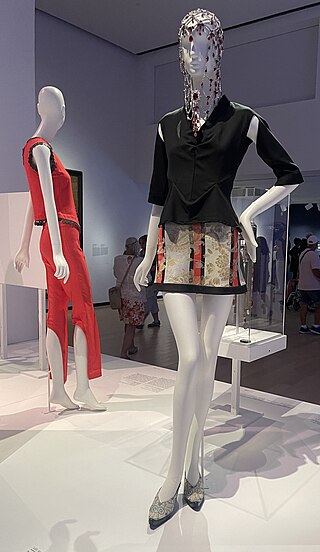
Eye was the fifteenth collection by British fashion designer Alexander McQueen for his eponymous fashion house. It was inspired by the culture of the Middle East, particularly Islamic clothing, as well as the oppression of women in Islamic culture and their resistance to it. The collection crossed traditional Middle Eastern garments with elements drawn from Western fashion such as sportswear and fetishwear. Jeweller and frequent McQueen collaborator Shaun Leane provided the collection's best-known design: a yashmak made from chainmail.

Jack the Ripper Stalks His Victims is the first collection by British designer Alexander McQueen, produced as the thesis collection for his master's degree in fashion at Central Saint Martins (CSM) art school. The collection's narrative was inspired by the victims of 19th-century London serial killer Jack the Ripper, with aesthetic inspiration from the fashion, erotica, and prostitution practices of the Victorian era. The collection was presented on the runway at London Fashion Week on 16 March 1992, as the second-to-last of the CSM graduate collections. Editor Isabella Blow was fascinated by the runway show and insisted on purchasing the entire collection, later becoming McQueen's friend and muse.
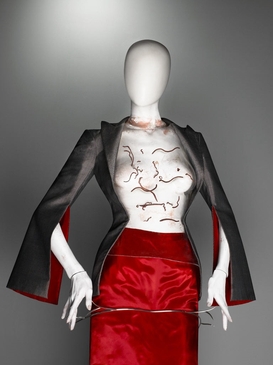
The Hunger is the seventh collection by British designer Alexander McQueen for his eponymous fashion house. The collection was primarily inspired by The Hunger, a 1983 erotic horror film about vampires. McQueen had limited financial backing, so the collection was created on a minimal budget. Typically for McQueen in the early stages of his career, the collection centred around sharply tailored garments and emphasised female sexuality. It was his first collection to include menswear.

Pantheon ad Lucem is the twenty-fourth collection by British designer Alexander McQueen for his eponymous fashion house. Inspired by ideas of rebirth, ancient Greek garments and science fiction films including 2001: A Space Odyssey (1968) and Star Wars (1977), the collection focused on sleek draped, wrapped, or tied jersey designs in light and neutral colours, with some eveningwear in darker colours. Contrasting the slimline items were heavier garments including tweed suits and fur coats. McQueen expressed his fascination with altering the silhouette, emphasising the hips to a degree that was uncommon for him.

The Girl Who Lived in the Tree is the thirty-second collection by British fashion designer Alexander McQueen, made for the Autumn/Winter 2008 season of his eponymous fashion house. The primary inspirations were British culture and national symbols, particularly the British monarchy, as well as the clothing of India during the British Raj. The collection was presented as a fairy tale about a feral girl who lived in a tree before falling in love with a prince and descending to earth to become a princess, and the runway show was divided into two phases to represent this narrative. In the first phase, the ensembles were all in black and white, with most looks having a slim, tailored silhouette. The clothing from the second half was richly coloured, with luxurious materials and embellishments, representing the girl's transformation into a princess.


